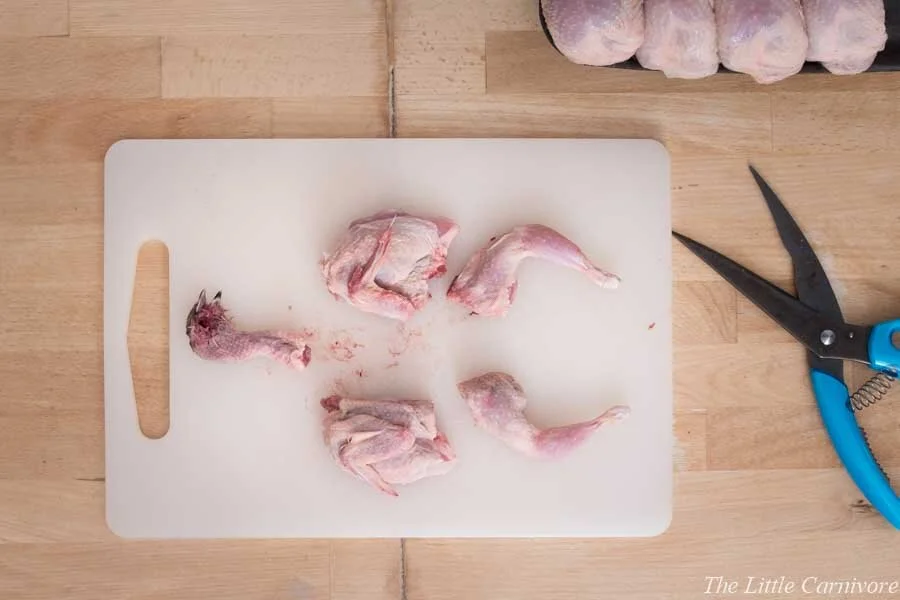Raw meaty bones in a raw diet
In this third article of the prey model diet ingredients series, we are going to cover raw meaty bones. Don’t remember what’s a prey model diet? Here’s the article on raw feeding.
In case you missed it, check out the article on meat and the article on organs, the first and second ingredients in the prey model diet.
What are raw meaty bones?
Raw meaty bones are edible bones with meat around, coming from animals the same size of a cat’s prey.
Why are bones mandatory?
It is important to understand that bones are mandatory in a raw diet. A diet without bones is going to be severely deficient: bones provide calcium, phosphorus and several other essential nutrients.
Quails
How to feed bones?
Bones required characteristics
Bones needs to be:
Raw: never feed cooked or dehydrated bones, as they will splinter! As a precaution, I would also advise not to feed freeze-dried bones.
With meat around. Naked bones are dangerous.
Adapted to the size of a cat. A cat won't be able to eat bones which are too big and may damage its teeth trying.
Uncut, except if you cut two separate bones at the level of the joints.
Risk of bones
Feeding bones may sound really scary. However, most outdoor/feral cats hunt birds and mice. They often eat them, including the bones, without any problem, as it’s their natural food.
Nevertheless, zero risk doesn't really exist, as with everything else. So, you should always supervise your animal when it is eating bones.
Finally, be aware that feeding too much bones may cause constipation and even an occlusion.
Which types of bones you can feed
So here is a list of bones adapted to a cat:
Quail bones (all can be fed)
Rabbit ribs
Coquelet (young chicken), any parts
Chicken neck
Small chicken wings
Rabbit front legs
Chicken feet
Chicken back
Small duck neck
For a cat starting with raw feeding, I would recommend either quail bones or rabbit ribs.
Variety in bones
Like for the meat, you should feed a variety of different types of bones.
It is very important not to feed only chicken necks, as they may cause hyperthyroidism.
As an example, Néline eats quail bones, rabbit bones, and chicken necks.
How to cut a quail with kitchen scissors
How much bones to feed
There are two methods used to calculate the amount of needed bones for your cat.
Method one: pure bones
A cat requires around 6% to 10% of pure bones in its daily ration.
For example:
A chicken neck = 36% bones + 64% meat.
Let’s say the daily ration for your cat is 100 g (3.53 oz). Your cat needs 6% of pure bones, so he needs 6% x 100 g (6% x 3.53 oz) of pure bones, which is equal to 6 grams (0.21 oz). Now it’s time to calculate how much chicken neck we need so that the 36% of pure bones content results in 6 g (0.21 oz). With a cross multiplication you get: x = 100 x 6g / 36 = 17g (x = 100 x 0.21 oz / 36 = 0.60 oz)!
You can use the following formula to calculate how much raw meaty bones your cat needs: Quantity of raw meaty bones (in grams or ounces) = Daily ration (in grams or ounces) x bones need (6% to 10%) / Percentage of pure bones in the raw meaty bone.
Method one pros: more precise
Method one cons:
it may be hard to find the bone percentage of a raw meaty bone.
a lot of calculations
If you choose this method, here are some links that can help you do the required calculations: raw meaty bones calculator, bone percentages in raw meaty bones.
Néline having a quail leg and beef meat for dinner
Method two: raw meaty bones
A cat needs around 30% of raw meaty bones in its daily ration.
Assuming that you don’t always feed the same type of bones, this method is based on the fact that if 30% of the daily ration is composed of raw meaty bones, on average this will translate in feeding your cat with 6% to 10% of pure bones.
So, if your cat daily ration is 100g, you need to feed 30g of raw meaty bones.
Method two pros: easier to calculate
Method two cons: less precise, especially for the case of atypical bones such as chicken feet, which are composed of 60% pure bones.
How does Néline eat bones?
I started to feed Néline following method two. After a period of adjustment, now I know precisely how much raw meaty bones she needs for the three types of bones I give her. I know that she needs 30g of chicken necks, or half a quail, for example.
Troubleshooting: how do I know how much bones is too much or not enough?
If your cat poop is whiter than usual, it means you are feeding too much bones.
If your cat poop is too soft/liquid, it means you are not feeding enough bones.
To conclude, bones are a mandatory part of a raw diet, as they provide essential nutrients.
They may be scary at first, but with the appropriate precaution, raw edible bones are safe for cats.
In a future article, we will talk of another ingredient of the raw diet: fish.
You can find the content of this article in video (with English subtitles):


